fa04_eldenfm1.qxp 2/28/2007 3:24 PM Page 1
Matrix Methods
in Data Mining
and Pattern
Recognition
�
fa04_eldenfm1.qxp 2/28/2007 3:24 PM Page 2
Fundamentals of Algorithms
Editor-in-Chief: Nicholas J. Higham, University of Manchester
The SIAM series on Fundamentals of Algorithms is a collection of short user-oriented books on state-
of-the-art numerical methods. Written by experts, the books provide readers with sufficient knowledge
to choose an appropriate method for an application and to understand the method’s strengths and
limitations. The books cover a range of topics drawn from numerical analysis and scientific computing.
The intended audiences are researchers and practitioners using the methods and upper level
undergraduates in mathematics, engineering, and computational science.
Books in this series not only provide the mathematical background for a method or class of methods
used in solving a specific problem but also explain how the method can be developed into an
algorithm and translated into software. The books describe the range of applicability of a method and
give guidance on troubleshooting solvers and interpreting results. The theory is presented at a level
accessible to the practitioner. MATLAB® software is the preferred language for codes presented since it
can be used across a wide variety of platforms and is an excellent environment for prototyping,
testing, and problem solving.
The series is intended to provide guides to numerical algorithms that are readily accessible, contain
practical advice not easily found elsewhere, and include understandable codes that implement the
algorithms.
Editorial Board
Peter Benner
Technische Universität Chemnitz
John R. Gilbert
University of California, Santa Barbara
Michael T. Heath
University of Illinois, Urbana-Champaign
C. T. Kelley
North Carolina State University
Cleve Moler
The MathWorks
James G. Nagy
Emory University
Series Volumes
Dianne P. O’Leary
University of Maryland
Robert D. Russell
Simon Fraser University
Robert D. Skeel
Purdue University
Danny Sorensen
Rice University
Andrew J. Wathen
Oxford University
Henry Wolkowicz
University of Waterloo
Eldén, L., Matrix Methods in Data Mining and Pattern Recognition
Hansen, P. C., Nagy, J. G., and O’Leary, D. P., Deblurring Images: Matrices, Spectra, and Filtering
Davis, T. A., Direct Methods for Sparse Linear Systems
Kelley, C. T., Solving Nonlinear Equations with Newton’s Method
�
fa04_eldenfm1.qxp 2/28/2007 3:24 PM Page 3
Lars Eldén
Linköping University
Linköping, Sweden
Matrix Methods
in Data Mining
and Pattern
Recognition
Society for Industrial and Applied Mathematics
Philadelphia
�
fa04_eldenfm1.qxp 2/28/2007 3:24 PM Page 4
Copyright © 2007 by the Society for Industrial and Applied Mathematics.
10 9 8 7 6 5 4 3 2 1
All rights reserved. Printed in the United States of America. No part of this book may be reproduced,
stored, or transmitted in any manner without the written permission of the publisher. For information,
write to the Society for Industrial and Applied Mathematics, 3600 University City Science Center,
Philadelphia, PA 19104-2688.
Trademarked names may be used in this book without the inclusion of a trademark symbol. These
names are used in an editorial context only; no infringement of trademark is intended.
Google is a trademark of Google, Inc.
MATLAB is a registered trademark of The MathWorks, Inc. For MATLAB product information, please
contact The MathWorks, Inc., 3 Apple Hill Drive, Natick, MA 01760-2098 USA, 508-647-7000,
Fax: 508-647-7101, info@mathworks.com, www.mathworks.com
Figures 6.2, 10.1, 10.7, 10.9, 10.11, 11.1, and 11.3 are from L. Eldén, Numerical linear algebra in
data mining, Acta Numer., 15:327–384, 2006. Reprinted with the permission of Cambridge University
Press.
Figures 14.1, 14.3, and 14.4 were constructed by the author from images appearing in P. N.
Belhumeur, J. P. Hespanha, and D. J. Kriegman, Eigenfaces vs. fisherfaces: Recognition using class
specific linear projection, IEEE Trans. Pattern Anal. Mach. Intell., 19:711–720, 1997.
Library of Congress Cataloging-in-Publication Data
Eldén, Lars, 1944-
Matrix methods in data mining and pattern recognition / Lars Eldén.
p. cm. — (Fundamentals of algorithms ; 04)
Includes bibliographical references and index.
ISBN 978-0-898716-26-9 (pbk. : alk. paper)
1. Data mining. 2. Pattern recognition systems—Mathematical models. 3. Algebras,
Linear. I. Title.
QA76.9.D343E52 2007
05.74—dc20
2006041348
is a registered trademark.
�
book
2007/2/2
page v
Contents
Preface
I
1
2
3
4
Linear Algebra Concepts and Matrix Decompositions
Vectors and Matrices in Data Mining and Pattern Recognition
Data Mining and Pattern Recognition . . . . . . . . . . . . . . .
1.1
Vectors and Matrices . . . . . . . . . . . . . . . . . . . . . . . .
1.2
Purpose of the Book . . . . . . . . . . . . . . . . . . . . . . . .
1.3
1.4
Programming Environments . . . . . . . . . . . . . . . . . . . .
Floating Point Computations . . . . . . . . . . . . . . . . . . . .
1.5
1.6
Notation and Conventions
. . . . . . . . . . . . . . . . . . . . .
Vectors and Matrices
2.1
2.2
2.3
2.4
2.5
2.6
Matrix-Vector Multiplication . . . . . . . . . . . . . . . . . . . .
Matrix-Matrix Multiplication . . . . . . . . . . . . . . . . . . .
Inner Product and Vector Norms
. . . . . . . . . . . . . . . . .
Matrix Norms . . . . . . . . . . . . . . . . . . . . . . . . . . . .
Linear Independence: Bases
. . . . . . . . . . . . . . . . . . . .
The Rank of a Matrix . . . . . . . . . . . . . . . . . . . . . . . .
Linear Systems and Least Squares
3.1
3.2
3.3
3.4
3.5
3.6
LU Decomposition . . . . . . . . . . . . . . . . . . . . . . . . . .
Symmetric, Positive Definite Matrices . . . . . . . . . . . . . . .
Perturbation Theory and Condition Number . . . . . . . . . . .
Rounding Errors in Gaussian Elimination . . . . . . . . . . . . .
Banded Matrices . . . . . . . . . . . . . . . . . . . . . . . . . . .
The Least Squares Problem . . . . . . . . . . . . . . . . . . . .
Orthogonality
4.1
4.2
4.3
4.4
Orthogonal Vectors and Matrices
. . . . . . . . . . . . . . . . .
Elementary Orthogonal Matrices . . . . . . . . . . . . . . . . . .
Number of Floating Point Operations . . . . . . . . . . . . . . .
Orthogonal Transformations in Floating Point Arithmetic
. . .
v
ix
3
3
4
7
8
8
11
13
13
15
17
18
20
21
23
23
25
26
27
29
31
37
38
40
45
46
�
book
2007/2/23
page vi
Contents
QR Decomposition
5.1
5.2
5.3
5.4
5.5
5.6
Orthogonal Transformation to Triangular Form . . . . . . . . .
Solving the Least Squares Problem . . . . . . . . . . . . . . . .
Computing or Not Computing Q . . . . . . . . . . . . . . . . .
Flop Count for QR Factorization . . . . . . . . . . . . . . . . .
Error in the Solution of the Least Squares Problem . . . . . . .
Updating the Solution of a Least Squares Problem . . . . . . . .
Singular Value Decomposition
6.1
6.2
6.3
6.4
6.5
6.6
The Decomposition . . . . . . . . . . . . . . . . . . . . . . . . .
Fundamental Subspaces . . . . . . . . . . . . . . . . . . . . . . .
Matrix Approximation . . . . . . . . . . . . . . . . . . . . . . .
Principal Component Analysis . . . . . . . . . . . . . . . . . . .
Solving Least Squares Problems . . . . . . . . . . . . . . . . . .
Condition Number and Perturbation Theory for the Least Squares
Problem . . . . . . . . . . . . . . . . . . . . . . . . . . . . . . .
Rank-Deficient and Underdetermined Systems . . . . . . . . . .
Computing the SVD . . . . . . . . . . . . . . . . . . . . . . . .
Complete Orthogonal Decomposition . . . . . . . . . . . . . . .
6.7
6.8
6.9
Reduced-Rank Least Squares Models
7.1
7.2
Truncated SVD: Principal Component Regression . . . . . . . .
A Krylov Subspace Method . . . . . . . . . . . . . . . . . . . .
Tensor Decomposition
8.1
8.2
8.3
8.4
Introduction . . . . . . . . . . . . . . . . . . . . . . . . . . . . .
Basic Tensor Concepts
. . . . . . . . . . . . . . . . . . . . . . .
A Tensor SVD . . . . . . . . . . . . . . . . . . . . . . . . . . . .
Approximating a Tensor by HOSVD . . . . . . . . . . . . . . .
47
47
51
52
53
53
54
57
57
61
63
66
66
69
70
72
72
75
77
80
91
91
92
94
96
Clustering and Nonnegative Matrix Factorization
9.1
9.2
101
The k-Means Algorithm . . . . . . . . . . . . . . . . . . . . . . 102
Nonnegative Matrix Factorization . . . . . . . . . . . . . . . . . 106
vi
5
6
7
8
9
II Data Mining Applications
10 Classification of Handwritten Digits
113
Handwritten Digits and a Simple Algorithm . . . . . . . . . . . 113
Classification Using SVD Bases
. . . . . . . . . . . . . . . . . . 115
Tangent Distance . . . . . . . . . . . . . . . . . . . . . . . . . . 122
10.1
10.2
10.3
11.1
11.2
11.3
11.4
11 Text Mining
129
. . . . . . . . . . . . 130
Preprocessing the Documents and Queries
The Vector Space Model
. . . . . . . . . . . . . . . . . . . . . . 131
Latent Semantic Indexing . . . . . . . . . . . . . . . . . . . . . . 135
Clustering . . . . . . . . . . . . . . . . . . . . . . . . . . . . . . 139
�
book
2007/2/23
page vii
Contents
vii
11.5
11.6
11.7
Nonnegative Matrix Factorization . . . . . . . . . . . . . . . . . 141
LGK Bidiagonalization . . . . . . . . . . . . . . . . . . . . . . . 142
Average Performance . . . . . . . . . . . . . . . . . . . . . . . . 145
12 Page Ranking for a Web Search Engine
147
Pagerank . . . . . . . . . . . . . . . . . . . . . . . . . . . . . . . 147
Random Walk and Markov Chains . . . . . . . . . . . . . . . . . 150
The Power Method for Pagerank Computation . . . . . . . . . . 154
HITS . . . . . . . . . . . . . . . . . . . . . . . . . . . . . . . . . 159
12.1
12.2
12.3
12.4
13 Automatic Key Word and Key Sentence Extraction
161
13.1
Saliency Score . . . . . . . . . . . . . . . . . . . . . . . . . . . . 161
13.2 Key Sentence Extraction from a Rank-k Approximation . . . . . 165
14 Face Recognition Using Tensor SVD
169
Tensor Representation . . . . . . . . . . . . . . . . . . . . . . . 169
Face Recognition . . . . . . . . . . . . . . . . . . . . . . . . . . 172
Face Recognition with HOSVD Compression . . . . . . . . . . . 175
14.1
14.2
14.3
III Computing the Matrix Decompositions
15 Computing Eigenvalues and Singular Values
179
Perturbation Theory . . . . . . . . . . . . . . . . . . . . . . . . 180
The Power Method and Inverse Iteration . . . . . . . . . . . . . 185
Similarity Reduction to Tridiagonal Form . . . . . . . . . . . . . 187
The QR Algorithm for a Symmetric Tridiagonal Matrix . . . . . 189
Computing the SVD . . . . . . . . . . . . . . . . . . . . . . . . 196
The Nonsymmetric Eigenvalue Problem . . . . . . . . . . . . . . 197
Sparse Matrices . . . . . . . . . . . . . . . . . . . . . . . . . . . 198
The Arnoldi and Lanczos Methods
. . . . . . . . . . . . . . . . 200
Software . . . . . . . . . . . . . . . . . . . . . . . . . . . . . . . 207
15.1
15.2
15.3
15.4
15.5
15.6
15.7
15.8
15.9
Bibliography
Index
209
217
�
book
2007/2/23
page viii
�
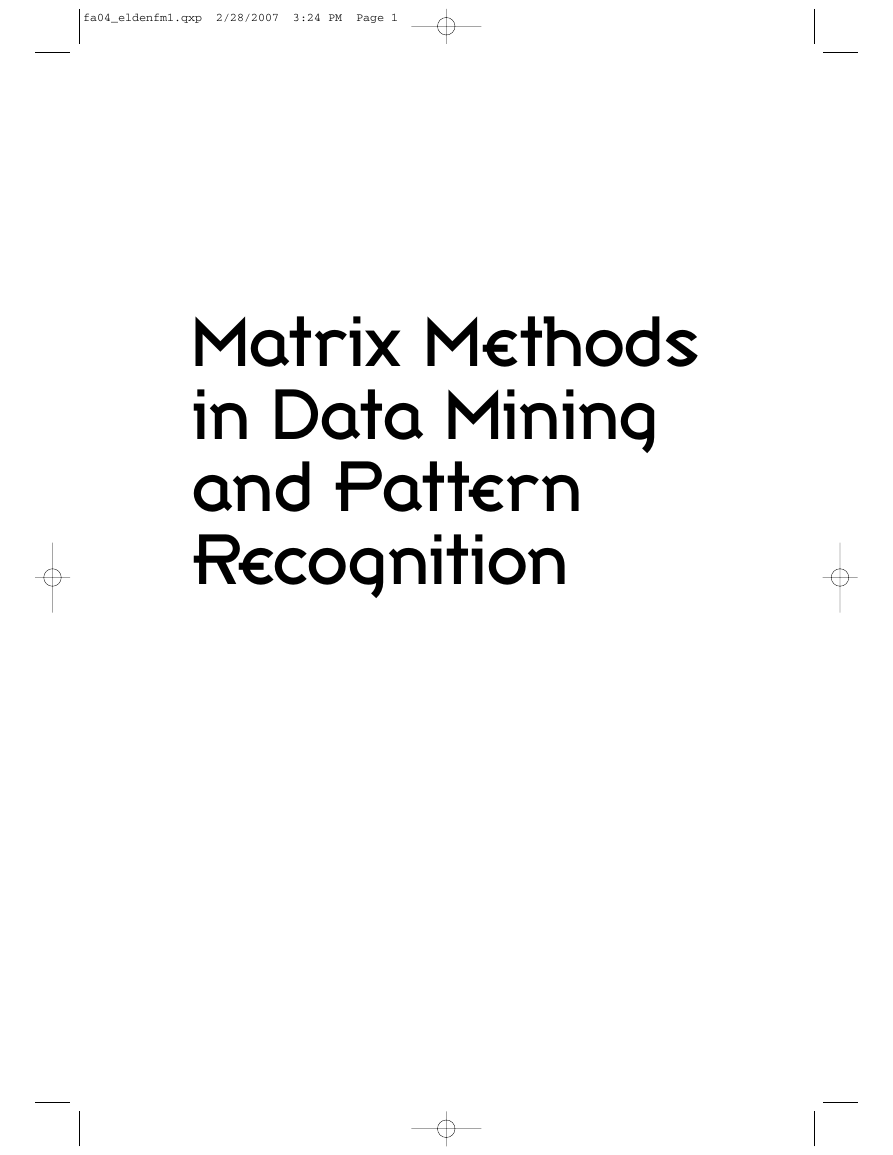


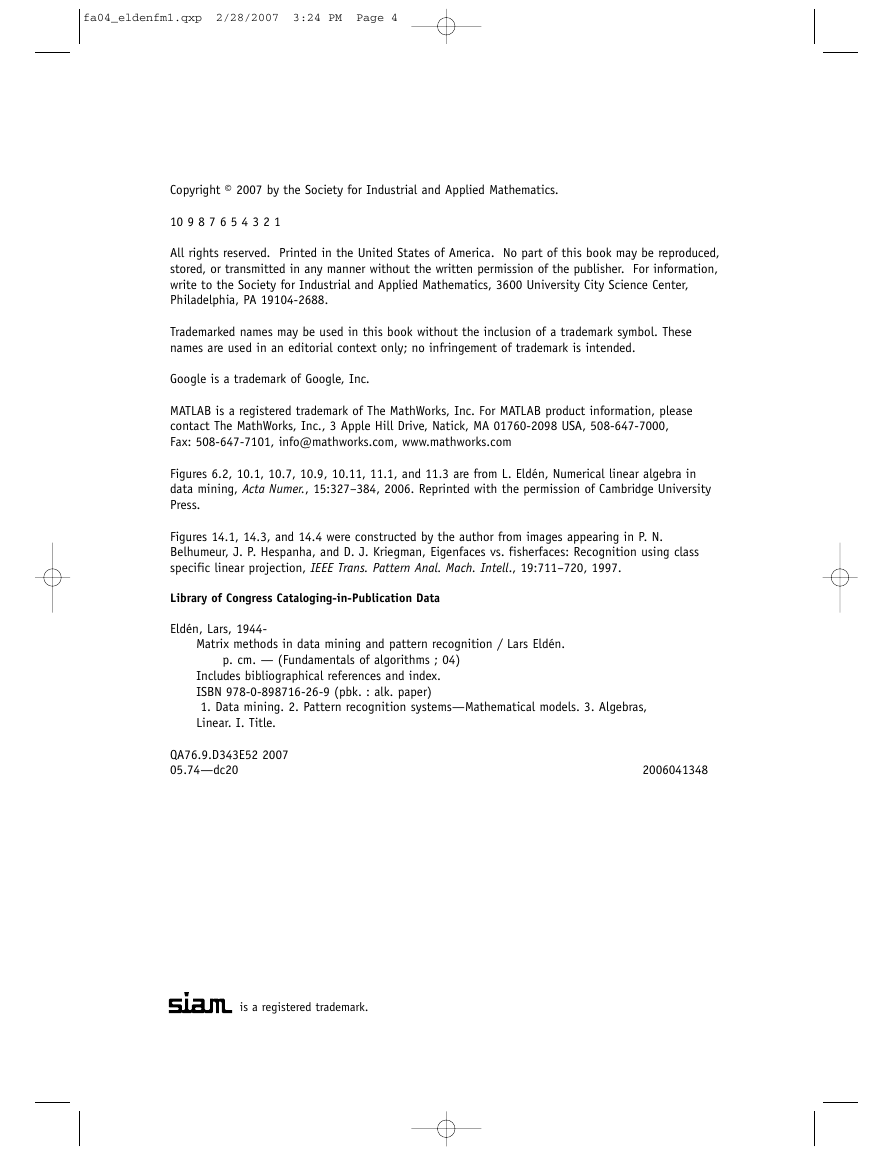
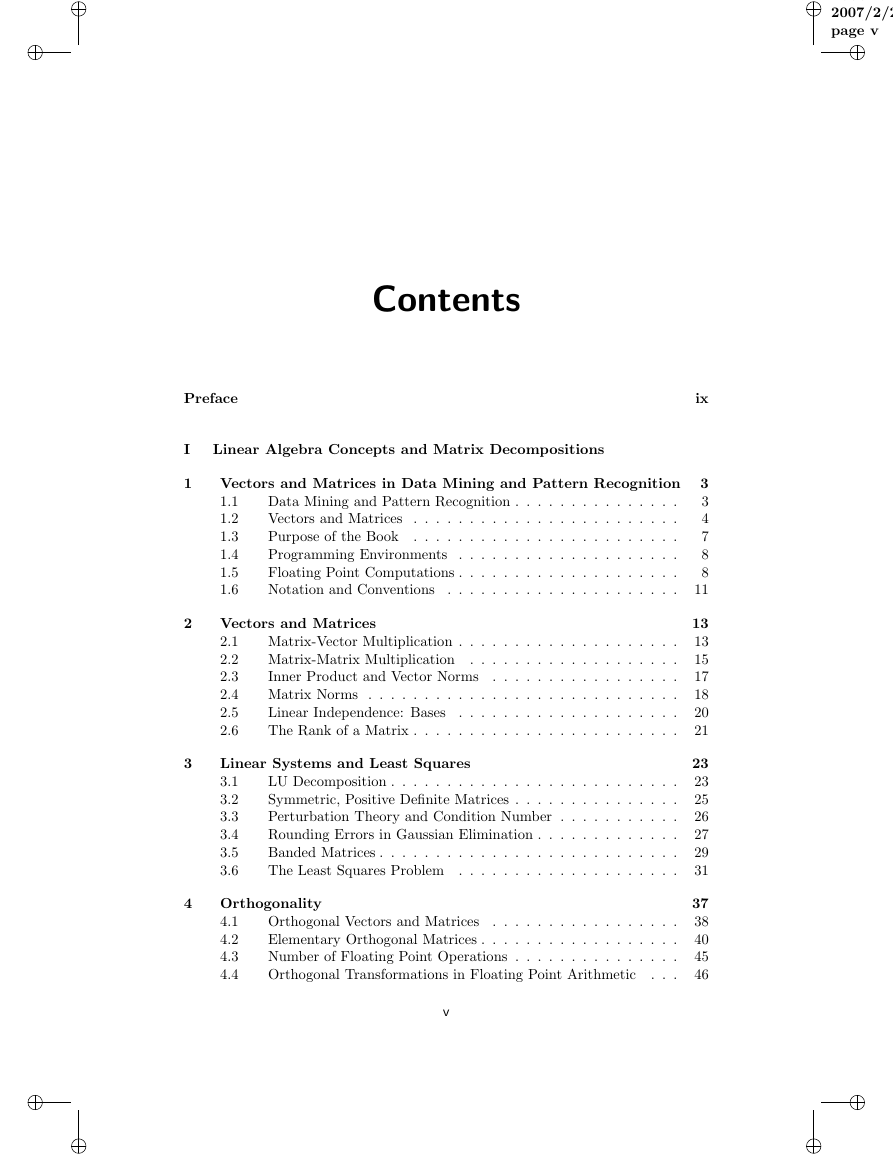
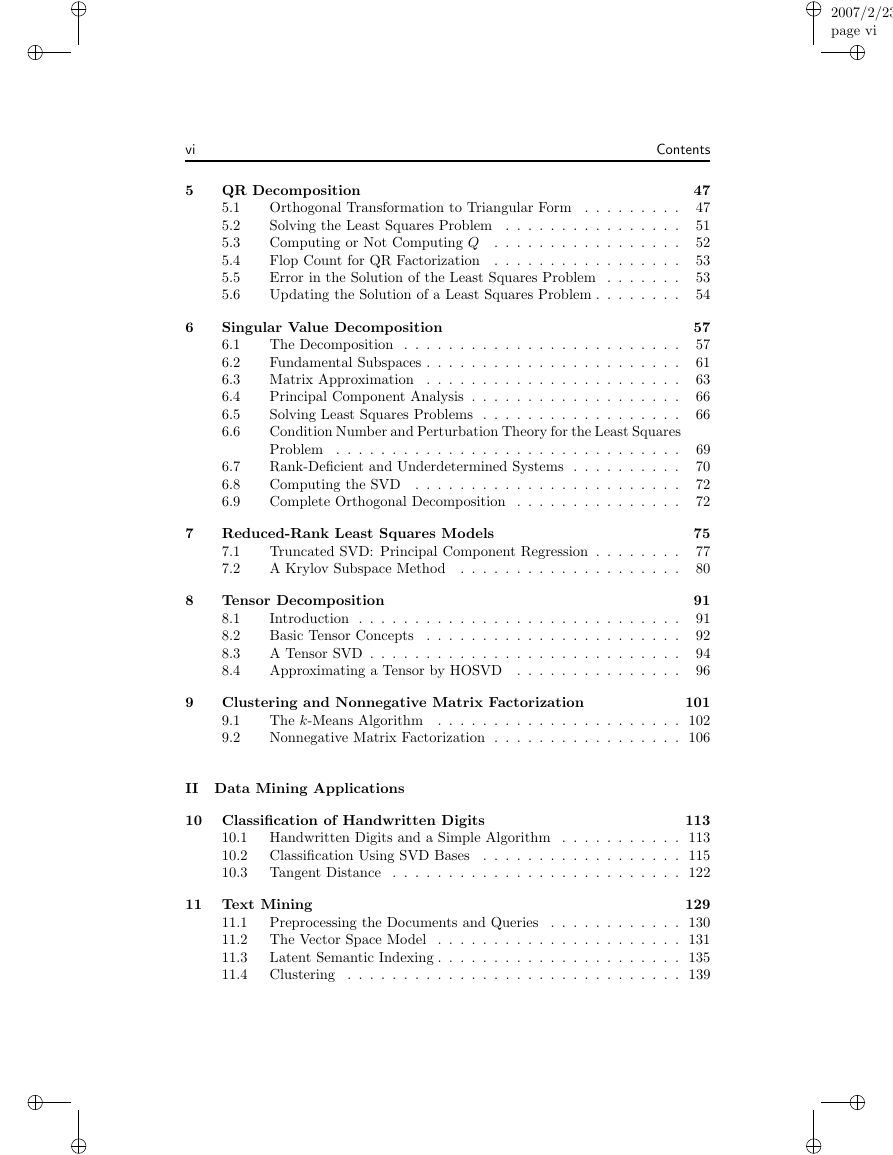
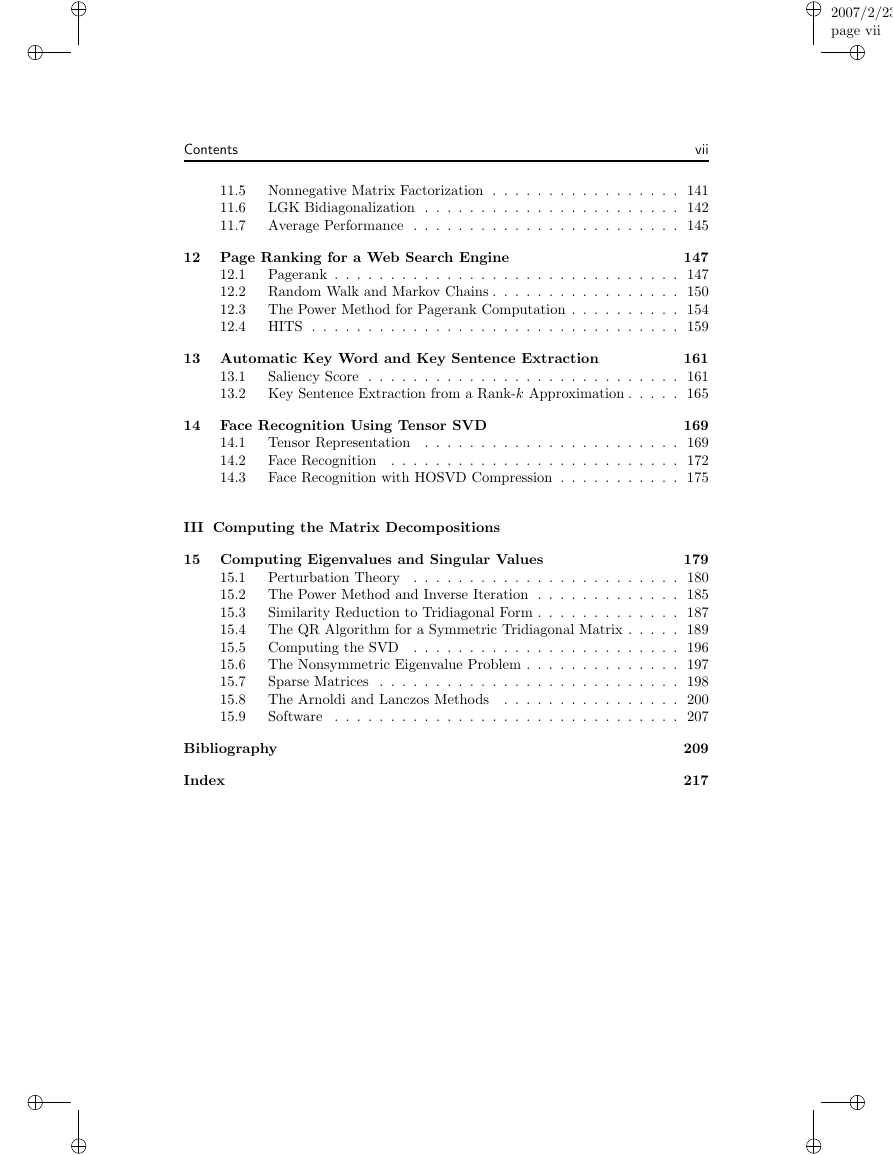









 2023年江西萍乡中考道德与法治真题及答案.doc
2023年江西萍乡中考道德与法治真题及答案.doc 2012年重庆南川中考生物真题及答案.doc
2012年重庆南川中考生物真题及答案.doc 2013年江西师范大学地理学综合及文艺理论基础考研真题.doc
2013年江西师范大学地理学综合及文艺理论基础考研真题.doc 2020年四川甘孜小升初语文真题及答案I卷.doc
2020年四川甘孜小升初语文真题及答案I卷.doc 2020年注册岩土工程师专业基础考试真题及答案.doc
2020年注册岩土工程师专业基础考试真题及答案.doc 2023-2024学年福建省厦门市九年级上学期数学月考试题及答案.doc
2023-2024学年福建省厦门市九年级上学期数学月考试题及答案.doc 2021-2022学年辽宁省沈阳市大东区九年级上学期语文期末试题及答案.doc
2021-2022学年辽宁省沈阳市大东区九年级上学期语文期末试题及答案.doc 2022-2023学年北京东城区初三第一学期物理期末试卷及答案.doc
2022-2023学年北京东城区初三第一学期物理期末试卷及答案.doc 2018上半年江西教师资格初中地理学科知识与教学能力真题及答案.doc
2018上半年江西教师资格初中地理学科知识与教学能力真题及答案.doc 2012年河北国家公务员申论考试真题及答案-省级.doc
2012年河北国家公务员申论考试真题及答案-省级.doc 2020-2021学年江苏省扬州市江都区邵樊片九年级上学期数学第一次质量检测试题及答案.doc
2020-2021学年江苏省扬州市江都区邵樊片九年级上学期数学第一次质量检测试题及答案.doc 2022下半年黑龙江教师资格证中学综合素质真题及答案.doc
2022下半年黑龙江教师资格证中学综合素质真题及答案.doc